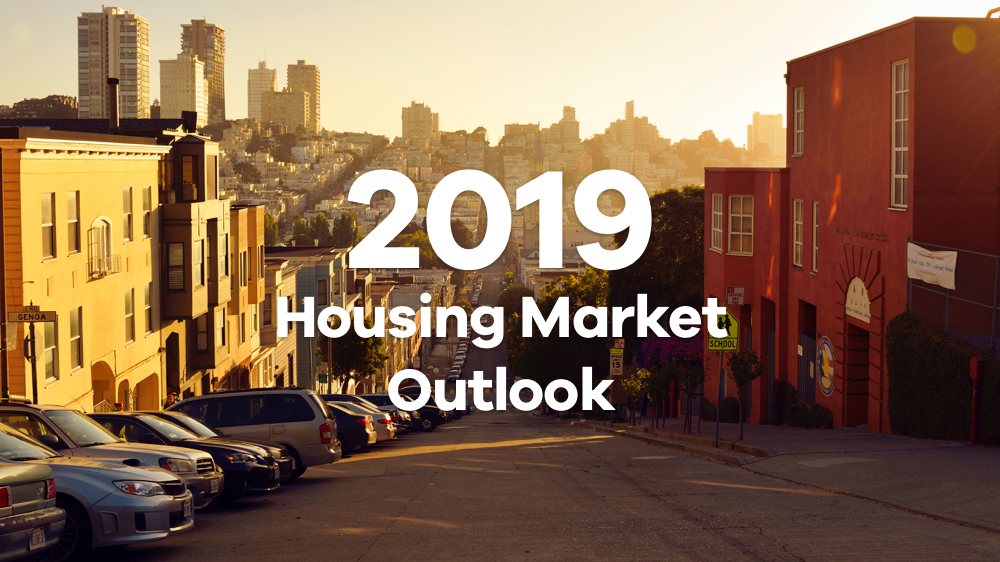After several years of frenzied homebuying, 2018 ushered in a turning point for the housing market as home price growth began to slow and mortgage rates rose. So, what will the new year bring?
Using insights from a new Trulia survey of more than 2,000 U.S. adults aged 18 and older, conducted online by The Harris Poll, and our housing research and analysis from the past year, we are making the following predictions about the U.S. housing market in 2019:
- Nationwide housing inventory will remain tight. Inventory has fallen almost non-stop for the past several years, and while several pricey coastal California markets saw an increase the number of for-sale starter and trade-up homes last quarter, they’re likely to be the exception and not the rule. And even if inventory begins to pick up in more markets, it will be rising from multi-year lows and will take a long while to get back to a more balanced level between buyers and sellers. With the construction industry facing significant headwinds from the higher cost of materials and labor as well as rising interest rates, we do not expect much if any growth in new construction starts in 2019 to help alleviate inventory woes.
- Worsening affordability will slow down home buying activity. Over the past several years, home price growth has largely outpaced income growth, making for an increasingly unaffordable home-buying environment. And next year, even as growth in home prices cools, limited supply will continue to help push prices up to some degree. The financial impediments of homeownership are acutely felt among renters who wish to buy: 53 percent say that saving enough for a down payment is the number one obstacle to homeownership, while 36 percent cite rising home prices.
- Mortgage rates will continue to rise in 2019, reaching 10-year highs. Mortgage rates on 30-year, fixed rate loans have been less than 5 percent since the end of the recession, helping to buoy housing demand and keep monthly payments relatively cheap even as prices themselves rose. But those record-low rates will come to an end in 2019. Rising mortgage rates will take a bite out of affordability on top of an already supply-constrained and high-priced housing market. Almost one in five (19 percent) renters who wish to buy said rising mortgage rates were their biggest obstacle to homebuying – up from 13 percent in April, before rates hit seven-year highs.
- Expect natural disasters to impact more communities in 2019, but have a moderate effect on the housing market overall. So far in 2018, Hurricanes Michael and Florence, along with devastating wildfires in California and numerous more localized disasters have damaged or destroyed tens of thousands of U.S. homes. Despite this, most Americans (52 percent) are no more or less concerned than before recent natural disasters about the potential threat of a natural disaster affecting their home. However, as these dramatic weather events continue to wreak havoc on communities, those prone to natural disasters will likely begin to turn to disaster-resistant construction and/or rely more heavily upon disaster insurance policies to insulate them from damage.
- More millennials will become first-time homebuyers in 2019. Younger Americans will continue to drive homeownership. After dropping to multi-decade lows in the years following the recession, the national homeownership rate is steadily rising and is currently at the same level it was in 2014. The largest gains in homeownership rates in recent years were among those under 35 years old. And more of these younger Americans say they intend to buy a home soon. Of Americans aged 18 to 34, 21 percent say they plan to buy within the next 12 months, up from 14 percent last year.
- Goodbye Silicon Valley, Hello Heartland. Colorado Springs, Grand Rapids, Jacksonville, Bakersfield, Austin are among the Top 10 Housing Markets to watch in 2019. Click here for the full list and to get more details on how we ranked each metro.
Methodology
This survey was conducted online within the United States by The Harris Poll on behalf of Trulia from November 7-9, 2018 among 2,021 U.S. adults ages 18 and older. This online survey is not based on a probability sample and therefore no estimate of theoretical sampling error can be calculated. For complete survey methodology for this survey or previous surveys, including weighting variables and subgroup sample sizes, please contact trends@trulia.com.


